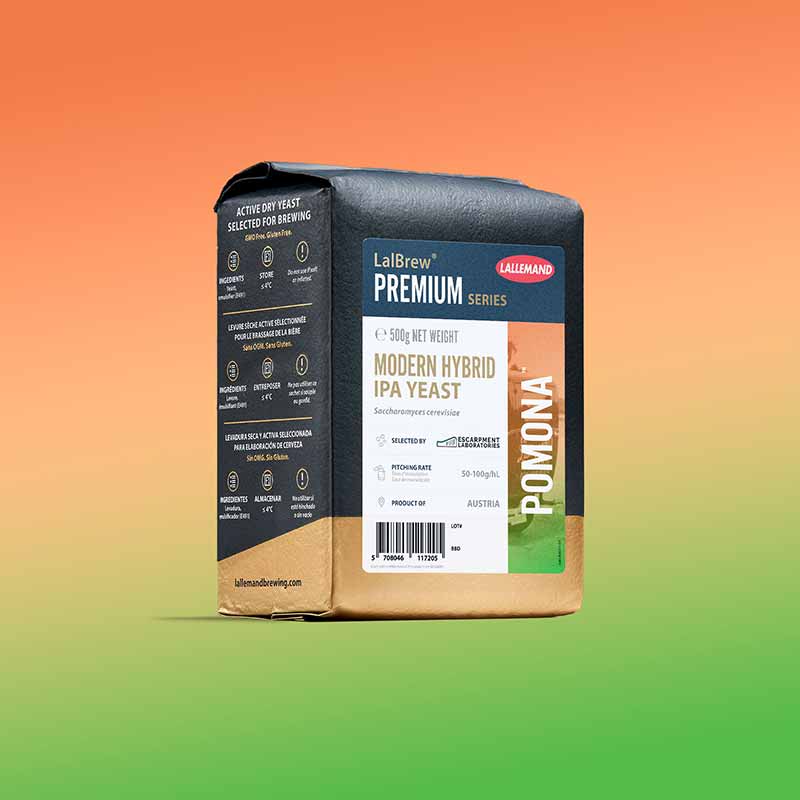
Every brewer understands the importance of happy, healthy yeast and making solid pitches to get a quality finished beer. Beyond the process, yeast can significantly influence your beer’s aromatics, flavor, and appearance. We’ve written about how a thiolized yeast like Cosmic Punch can elevate your beer—especially when paired with mash hopping—or how Berkeley Yeast’s LNA strains can improve your non-alcoholic beer offerings. Lallemand Brewing, or LalBrew, has created a hybrid yeast, Pomona™, that promises to provide a flavor and aroma boost for IPAs with a particular profile.
We chatted with LalBrew Technical Support Manager Eric Abbott to define Pomona™, share its R&D history, explain its benefits and stability, and show you exactly how to use it.
(Above photography courtesy of Lallemand)
Affordable, Industry-Leading Brewery Software
LalBrew Explains the R&D of Pomona Yeast

Photography courtesy of Lallemand
According to LalBrew’s product page, Pomona is a hybrid yeast made in collaboration with Canada-based Escarpment Laboratories. Abbott says that Escarpment created Pomona as a liquid yeast years ago, and LalBrew reached out to work with the lab on creating the yeast as a dry strain because of Escarpment’s focus on innovations.
“Escarpment Labs is very strong in innovations and research. They do a lot of R&D. They’ve published scientific papers on yeast in peer-reviewed journals,” Abbott says. “And Lallemand Brewing is strongly focused on innovation and bringing to market strains that are not only trendy but innovative and unique.”
Escarpment Laboratories Co-Founder Richard Preiss says the Pomona strain is a prime example of yeast hybridization that combines traits from different yeast families to achieve a unique balance of efficiency and flavor.
“Our goal for this strain was to create a new yeast option for IPAs—especially hazy IPAs—that pushes peach and stone fruit aromatics,” Preiss says. “That is also compatible with a wide range of ABV from session pale ale to triple IPA.”
Lallemand previously built a relationship with Escarpment when they took Escarpment’s house ale liquid yeast strain a little over a year ago and put it into dry form. They have been working closely with Escarpment since, partnering on the Pomona yeast strain.
“The idea behind selecting this strain is to produce yeast ideal for modern IPA styles but something different than what is currently on the market,” says Abbott of Pomona, named after the goddess of fruit trees. “[Escarpment] took a high-performing, very efficient, clean-fermenting yeast strain—kind of a workhorse in the brewery—and used selective breeding to breed that [workhorse] strain with a highly aromatic strain.”
The hybrid strain came from Sterling, a Scottish-British genetic background with very efficient fermentation and low aroma, and Cerberus, an STA1 positive saison strain, though diastatic, with excellent aromatic formation.
“Basically mating these strains together, similar to crop breeding,” Abbott says. “[We’re] trying to combine the characteristics of the two parent breeds.”
Escarpment used adaptive laboratory evolution, a process of training the yeast to perform in a specific environment or under particular stresses.
“They used high-gravity, highly hopped wort, basically a New England IPA wort,” Abbott says. “They fermented the yeast that came from the breeding and put it through more than fifty generations and propagations in IPA wort.”
Abbott adds, “They were basically training it to adapt to that type of fermentation environment.”
Abbott notes that the adaptive laboratory evolution helps stabilize the yeast’s genetics so it can be re-pitched and ensures it’s well adapted to IPA fermentations.
“The breeding resulted in a very efficient fermenting strain with very strong aromatics,” Abbott says. “Compared to the initial strain before the lab evolution, it’s faster and has a little bit higher attenuation.”
Preiss notes that stone fruit aroma is typically a combination of esters, terpenes, and lactones.
“We aimed to create a strain with the right ester and terpene transformation profile,” Preiss says. “We got the esters from our mating of two strains but found the hop transformation of the candidate hybrids to be lacking. So, we devised an adaptive laboratory evolution strategy to improve the candidates.”
Preiss adds, “The resulting adapted hybrid we chose is Pomona, which shows a lively balance of esters and terpene biotransformation that yields a delightful peach aroma in IPA-style beers.”
Abbott says the evolution led to “a beast of a strain” that ferments high-gravity IPAs very quickly and cleanly, producing pleasant peach, tropical, and stone fruit aromatics.
Preiss praised the collaboration with Lallemand. He says they shared a common goal and worked together from early on, to the trials, and then the launch.
“Launching Pomona under the LalBrew brand allows an Escarpment Labs developed yeast to access a global market for the first time,” Preiss says, “which has been very exciting and rewarding for us.”
Abbott compares Pomona to the LalBrew Verdant IPA™ strain but says Pomona has higher attenuation, and the aromas and flavors are “a little bit punchier and more intense.”
Lallemand was responsible for taking Pomona’s liquid form, drying it, and bringing it to market. They then sent it globally for trials to develop a characterization of the strain.
“We sent samples out to Europe, Australia, New Zealand, Canada, the U.S., Mexico,” Abbott says. “And based on those trials, we characterized the dry form of the strain.”
Abbott says during this year’s Craft Brewers Conference, breweries shared more of these trial beers.
And Lallemand commercially launched Pomona in June.
What Are the Benefits of Pomona Yeast?
Abbott sees several benefits of Pomona.
“It creates a unique flavor profile,” he says. “And it creates a stable haze developed specifically for IPA fermentations.”
According to Abbott, Pomona provides a “high biotransformation potential,” another benefit, especially in hazy IPAs, a style where the strain works well.
“Robust and consistent fermentation is another [benefit],” Abbott adds. “And there is high attenuation without over attenuating or breaking down any dextrins.”
Preiss echoes Abbott in that Pomona brings a lot to the table.
“It makes unique beers, with its distinct stone fruit, tropical fruit, and citrus aroma profile,” Preiss says. “Depending on hops used and other recipe considerations.”
He adds that yeast gives brewers more value from hops because it can biotransform hop aromatics and produce beers faster.
“That’s thanks to efficient fermentation kinetics,” Preiss says. “And Pomona can make healthier, more efficient beers with lower final gravity—and thus lower calories, more efficiency—than conventional strains without tasting thin.”
BareBottle Co-Owner Lester Koga says he first learned of the Pomona strain during its R&D phase at the California Craft Beer Summit.
“I immediately thought of West Coast IPA,” Koga says. “So I anchored on it being a West Coast strain in my head and a West Coast recipe, and when it was released, they specifically call it a hazy strain.”
From that first experience, Koga says he wanted to get involved with using that strain. BareBottle has made three beers with the strain – Pomona Express, Gold Shine, and Tiger Dust.
For Pomona Express, Koga says “It finishes like a West Coast strain, but appearance-wise, it’s all hazy. We couldn’t clear this thing up, making it a great hazy strain for the future.”
Koga likes what the strain does to the beers he’s brewed with.
“The Pomona strain has a ton of character for a hazy yeast strain,” Koga says. “It reminds us a bit of the old Gigayeast 054 Conan strain. It’s got a ton of stonefruit esters to it, with over ripe peach and citrus in the aroma and a nice apricot twang in the mid-palate.”
Koga says they added a lot of Citra, Strata, and Simcoe hops to the beers and the added orange notes played well with the stonefruit.
“If you want a hazy strain with strong haze stability, this is definitely an option,” Koga says. “Because it’s a hazy West Coast strain, it gives you a nice mix of haze, but finishes drier … Though if you’re looking for a high finishing Plato hazy, then this may dry more than you’re expecting.”
Estonia-based Tuletorn Brewery Head Brewer Chris Pilkington had a chance to test Pomona Yeast during trials. In a testimonial, he said, “Overall impression – [Pomona is] absolutely fantastic. Easy to use, fast, incredibly versatile. Based off these brews, I feel there is so much more that can be done with it.”
Pilkington adds, “It’s easy for our production methods and an aroma that is just incredible. Honestly, in many years of brewing hazies, the performance from this out the pack was still mind-blowing.”
Basqueland Brewing Head of Brewing Operations Oscar Saenz said during trials that Pomona was one of the more exciting yeasts he has trialed.
“It delivers such a nice tropical juicy character that complements perfectly with heavy dry hop additions like we do at Basqueland Brewing,” Saenz said in a testimonial. “It’s a fast-fermenting yeast that works well for all our hazy beers.”
How Stable Is Pomona Yeast?

Photography courtesy of Lallemand
According to Abbott, the Pomona yeast strain has many layers of stability thanks to the adaptive lab evolution.
Because of the adaptive lab evolution process, Abbott says the Pomona dry yeast strain is exceptionally stable and can withstand countless generations of re-pitching.
“Because of the tolerance to IPA environment and general fast fermentation kinetics, Pomona will be more competitive than most other yeasts and is therefore highly re-pitchable,” Abbott says. “It’s tough to pin down a specific number [of generations you can get from Pomona] since this depends highly on the yeast handling at the brewery.”
Abbott adds, “If you are already re-pitching yeast, then you should be able to get as many or more generations with Pomona.”
You should pitch the strain at around fifty to one hundred grams per hectoliter and ferment at temperatures between eighteen and twenty-two degrees Celsius. Lallemand also provides a pitch rate calculator for ease of use for Pomona and all its dry yeast strains.
The attenuation from that pitch is high, around seventy-five to eighty-four percent, which completes in four to five days. The tolerance of the strain is up to 10% ABV.
“It performs well in high-gravity fermentations,” Abbott says. “And compares well to other high-gravity strains.”
He adds, “Because the attenuation is a little bit higher, the flavor profile tends to be a bit more clean-bodied with punchier aromatics.”
Which Beer Style Is Best for Pomona Yeast?
Abbott says that most people use Pomona yeast in hazy and juicy IPAs, but he sees it working well beyond just those two IPA iterations.
“In some ways, it’s an interesting blend between East Coast and West Coast,” he says. “It’s higher attenuation, and because it’s a little drier, it tends to the West Coast style. But it is very well suited especially for the hazy and juicy styles.”
He does believe it can work as a West Coast even with the stable haze it produces.
“Pomona does have a stone fruit and tropical characteristic to the yeast. Combine that with West Coast hops, and you could definitely produce a nice West Coast IPA, but it will have a stable haze,” Abbott says. “If you want to clear that up, you can definitely [need to] filter it or fine it. It clears well with some effort, but left on its own, it will maintain its haze.”
Koga feels this works well for one style.
“It’s a hazy strain through and through, with a drier finish and nice stonefruit character,” he says. “We went all IPAs with it.”



